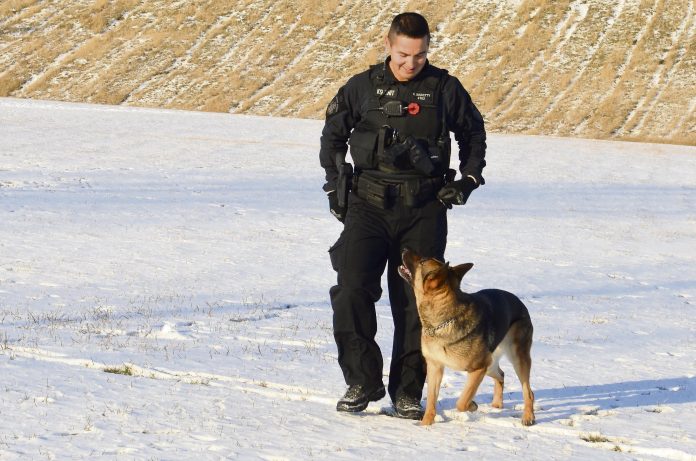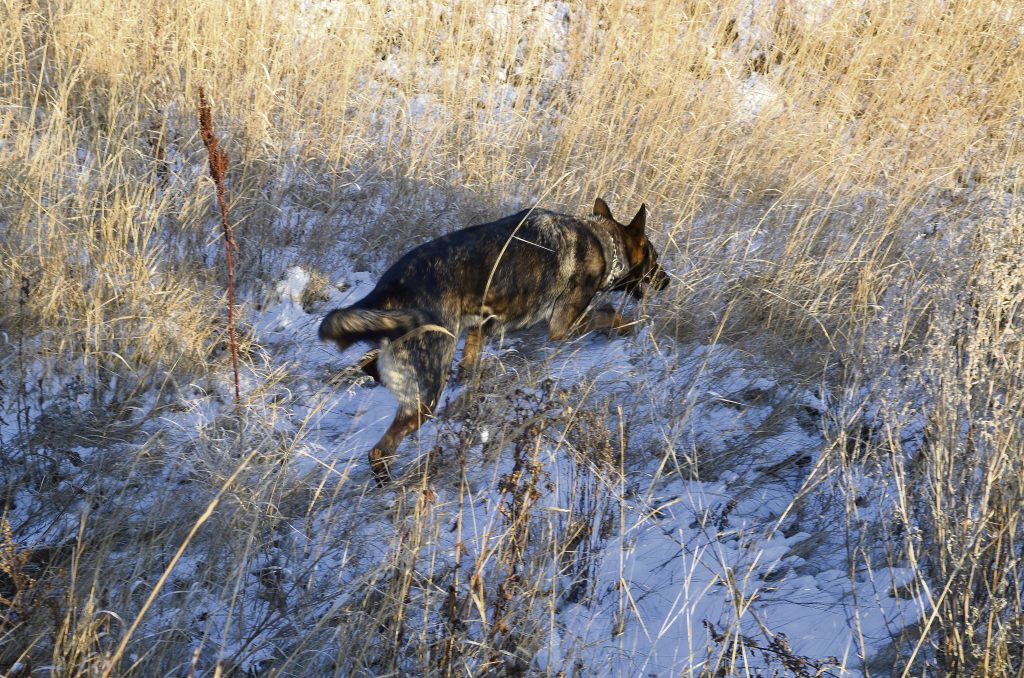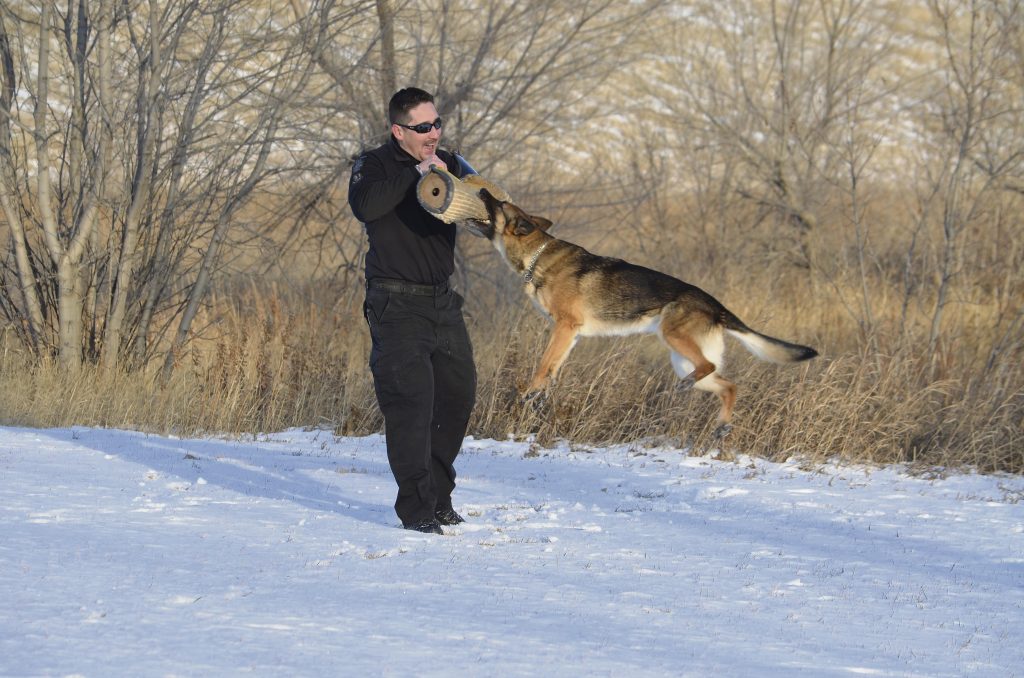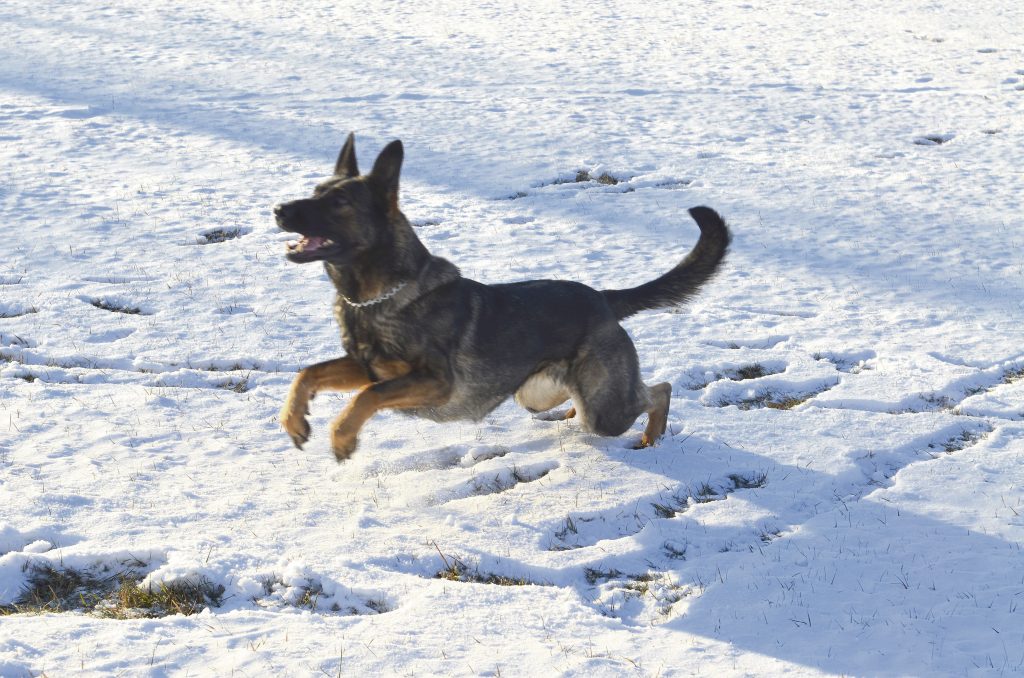
They’re two of the most popular, and prolific, officers on the Prince Albert Police Force.
Every week they’re in the news, tracking down bad guys and keeping other officers out of harms way.
But if you saw them on a day off, walking down the street or playing in the back yard, they would look like any other dog.
When it’s time to work, they know. And they turn it on.
Last Thursday, the Herald accompanied Police Service Dogs Daxa and Febee to a field by Sask. Polytech.
The dogs were energetic, playing fetch and running through a field.
But even this playtime could count as training. The dogs are told to wait, to heel, to go, and are even called off on their way to get their kongs, their favourite toys.
While some dogs are motivated by food, for these two, the toys are all they need. When they complete a task in training, they’re rewarded with the kong. Their handlers toss them across the fields, and the dogs head off, running, a streak of brown and black fur racing across the snow.
They return equally as energetic, and the dogs’ personalities begin to show.
PSD Febee is very focused on her handler, Const. Mike Chow. She’s fast, and playful, but isn’t bothered by the other dog handler standing by or the strange man with a digital camera.
Daxa is different. She wants to meet everyone around. As soon as she gets out of the police van, or, after she retrieves her kong, she runs up to each person nearby and gently jumps up to say hi. She investigates each person before returning to the feet of her handler, Const. Kelsey Bighetty.
The only thing the dogs don’t do is greet each other. They’re both alphas, so they have to be taken out one at a time.
Once the dogs have shown their basic obedience skills, it’s time to show off their police work.
It’s Febee’s turn first.
She is on a mission to track a missing item — Const. Bighetty’s hat. He’s tossed it somewhere in the long grass.

As soon as Febee receives her command to track, she’s off. Const. Chow barely has to intervene as the dog, nose to the earth, keenly tracks the scent. In minutes, she finds it, and lies down to show that she has located the item.
She’s trained not to pick it up or chew anything she finds while tracking, so potential evidence won’t be compromised.
Febee is rewarded once more with the kong, and races after it across the field. She’s sent back to her car kennel. Once the door is shut, she complains a little before settling into the back of the car.
Both dogs are vocal. While Febee is barking away, Daxa is whining to her handler.
It’s easy to forget what this dog is capable of, watching her play and say hi to the people once more. But Daxa has a job to do. And when it’s time, she’s ready. Const. Chow puts on a protective sleeve. Today, he’s the suspect. And he won’t comply.
Const. Bighetty sends Daxa, who equals the intensity with which she chased that beloved Kong. But the suspect is alarmed. He surrenders. All it takes is one command, and Daxa is called off. She lies down in front of the suspect, watching him carefully, ready to step back in if he tries to run or fight. She’ll also walk closely behind as the suspect is marched back to the police car, ever the watchful eye, guarding her handler.
The officers set up again. This time, Const. Chow, again playing the culprit, isn’t backing down.
Neither is Daxa. She launches herself into the air, latching onto the protective sleeve. If this weren’t a training exercise, that would be a suspect’s arm.
Chow tests Daxa, swinging his arm around in an effort to release himself from the dog’s hold. But she won’t budge. He surrenders, and the dog lets go, again keeping a watchful eye on the threat.

Thursday’s exercise was just a training run, but the skills demonstrated are not uncommon. Rarely a week goes by that the dogs aren’t brought in to track a suspect or help bring down someone who tries to run or fight back.
Constables Chow and Bighetty, and their canine companions, are busy.
“When someone flees from a violent crime, a lot of times the only way to find them is by using the dogs to track. They’re a huge asset to the service,” Chow says.
Bighetty agrees.
“We’re a very successful unit. If it weren’t for the dog, crimes wouldn’t be solved in a lot of incidents. They’re a huge impact for the service.”
Even when they’re not tracking down suspected culprits of crime, the dogs are being put through their paces. They have to demonstrate yearly that they’re cut out for the job.
“Obedience is probably one of the biggest profiles we train on. We do it constantly on days off,” Bighetty says.
“When we’re working, we do it every single night, throughout the night. The biggest exercise for the four of us is obedience.”
About twice a month, the dogs go out to work on their other skills.
The officers explained how they use the dogs to help with an arrest. The technique used is called bite and hold.
“When we send our dog to apprehend the suspect, they’re not necessarily going to chew up that person,” Bighetty says.
“The dog will go and latch on to whatever part of their body, and hang on to them until we get there to subdue the suspect or handcuff and take that person into custody.”
The dogs are often last resorts. Suspects are given verbal commands to comply. But if they’re running, or if they’re armed, the dogs can help take that person down.
“Nobody can outrun a four-legged dog,” Bighetty explains.
Sometimes, the dogs themselves are deterrents. That’s why they work on call-offs, like the one demonstrated in the field. Many suspects will surrender once they see over 50 pounds of muscle, fur and teeth hurtling towards them. Officers will give a command, and the dog will stop, watching carefully.
Others don’t comply with officer demands, and the dogs latch on. If they don’t resist, injuries will be minor, usually consisting of bruising or the odd puncture mark. However, if they do resist, injuries can increase.
“For the most part, a lot of guys that get bit give up,” Bighetty says.
“Nobody likes to get bit.”
Getting the dogs to the point where they can head out into the field and work in these dangerous situations takes years of training.

But dogs like Daxa and Febee are literally bred for the challenge. Both of the Prince Albert Police Service Dogs are from the RCMP breeding program in Innisfail, Alta. There, dogs are raised and either sent to RCMP detachments or sold as either working dogs or pets.
Working dogs go through imprinting, basic training on tracking and criminal apprehension. They head to their new jobs when they’re about one and a half to two years old.
In Prince Albert, the police then do more training on searches, evidence, obedience, agility, tracking and apprehension.
Daxa is six. She has been working for the Prince Albert Police for about four years. He only handler has been Const. Bighetty.
Febee is a bit younger. She just turned four. Like Daxa, Febee has only had one handler during her time with the P.A. police.
Police dogs serve for five years before they go through a review. Daxa is getting older. There will be a day where she won’t work anymore. When that will be depends on the dog, and on the handler.
“I know of dogs that have been in service for nine years. It all depends on the dog’s health, the team and how well you are producing,” says Bighetty.
“If you’re doing a really good job, and the dog is healthy, why would you stop a good thing? It all depends.”
With all the time the dogs and handlers spend together, the bonds they build are incredibly strong.
“The bonds we have with our dogs we can’t compare to anything else,” Chow explains. “We spend more time with our dogs than we do with our families. When we’re working, they’re with us for 12 hours. And on days off, we still spend as much time with them as we can, to get them out of their kennels and do something. Otherwise they just go crazy.”
That training pays off. When it’s time to go to work, the dogs are ready. They know what they have to do, and when they have to do it.
“They are extremely intelligent dogs,” Bighetty says. Daxa could be playing in the back yard with the kids, and then later we can be heading out and she can be chasing a dangerous suspect that has a weapon, and she puts her A-game on. It’s pretty amazing how they have that switch, and they know just by the tone of my voice when it’s downtime. They just know from reading us and reading the situation.”
When they aren’t chasing bad guys, the dogs enjoy time off. Passing them on the street, you wouldn’t know that just a few days earlier, they helped apprehend a suspected thief who tried to flee police.
And just like other officers, the dogs have unique personalities.
“Febee likes to relax and sleep,” Chow says. “She builds up her energy for work. She’s always super excited to go to work. If it was up to her, she would work every day.”
Daxa prefers a higher-energy lifestyle.
“I don’t know when she sleeps,” Bighetty says. “I haven’t seen her sleep. I’ve seen her doze off, maybe.”
Bighetty explains that just like humans, dogs need that time off to get ready for the next day of work. For Daxa, that means enjoying the life of a dog.
“Downtime is relaxing, being a normal dog; playing in the backyard or going for walks. In the summertime, Daxa loves swimming.
According to Bighetty, Daxa also loves playing with others.
“I have a little one at home, a six-year-old, and Daxa plays with them in the backyard all the time. They’re normal, happy, high energy dogs.”
But when playtime is over, it’s back to work for Daxa and Febee. It’s work they love, and work the community relies on to track down suspects who would otherwise escape.
“These dogs love what they do,” Bighetty says.
“We don’t force them to do it. They do it because they love it and want to please us. They’re high-energy dogs. They love to work.”

